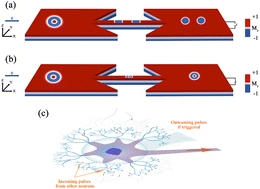Control and regulation of skyrmionic topological charge in a novel synthetic antiferromagnetic nanostructure†
Abstract
Skyrmionium is a combination of a skyrmion with a topological charge (Q is +1 or −1), resulting in a magnetic configuration with a total topological charge of Q = 0. Skyrmionium has distinctive characteristics, including a slightly higher velocity, motion restricted to the middle of the track without the skyrmion Hall effect (SkHE), and absence of an acceleration phase. However, there is little stray field due to the zero net magnetization, the topological charge Q is zero due to the magnetic configuration, and detecting skyrmionium is still challenging. In the present work, we propose a novel nanostructure composed of triple nanowires with a narrow channel. It was found that the skyrmionium is converted into a DW pair or skyrmion by the concave channel. It was also found that the topological charge Q can be regulated by Ruderman–Kittel–Kasuya–Yosida (RKKY) antiferromagnetic (AFM) exchange coupling. Moreover, we analyzed the mechanism of the function based on the Landau–Lifshitz–Gilbert (LLG) equation and energy variation and constructed a deep spiking neural network (DSNN) with a recognition accuracy of 98.6% with supervised learning via the spike timing dependent plasticity rule (STDP) by considering the nanostructure as an artificial synapse device corresponding to the electrical properties of the nanostructure. These results provide the means for skyrmion–skyrmionium hybrid application and neuromorphic computing applications.



 Please wait while we load your content...
Please wait while we load your content...